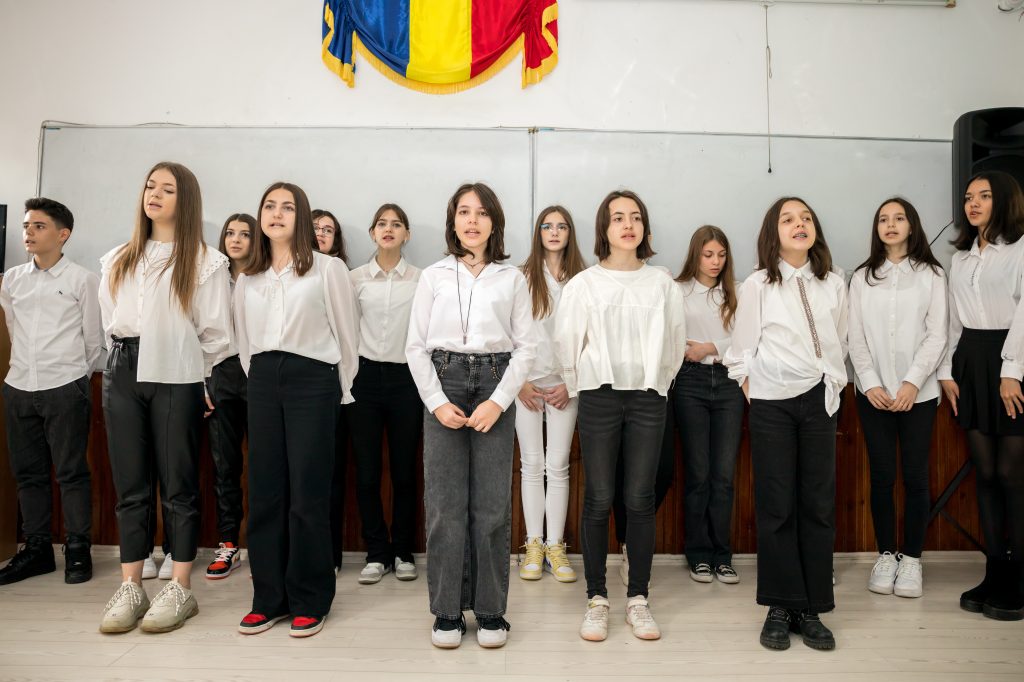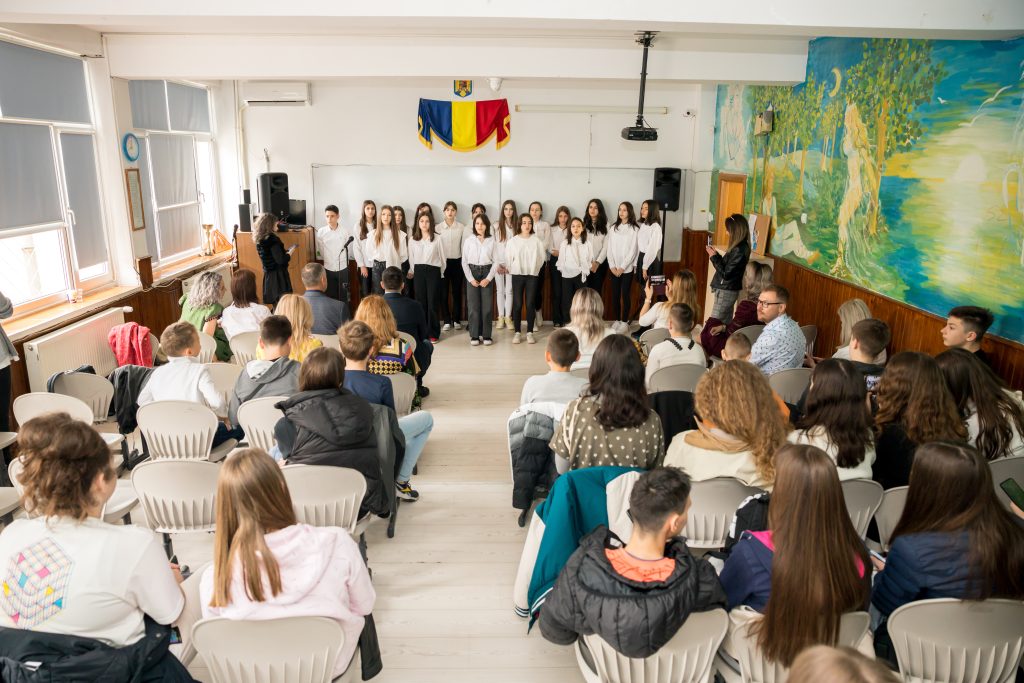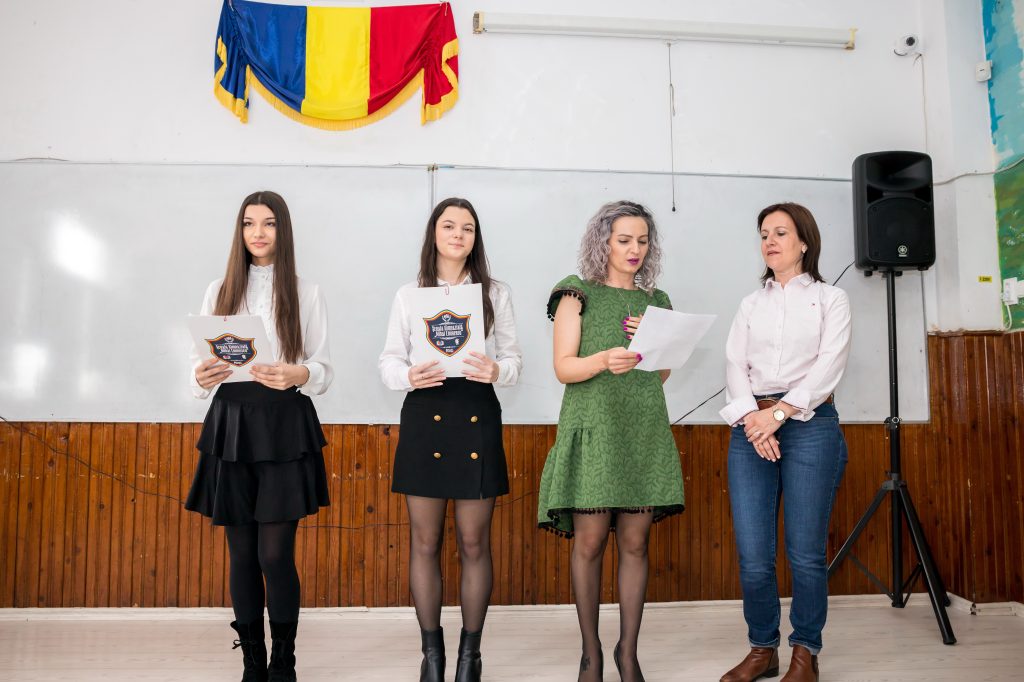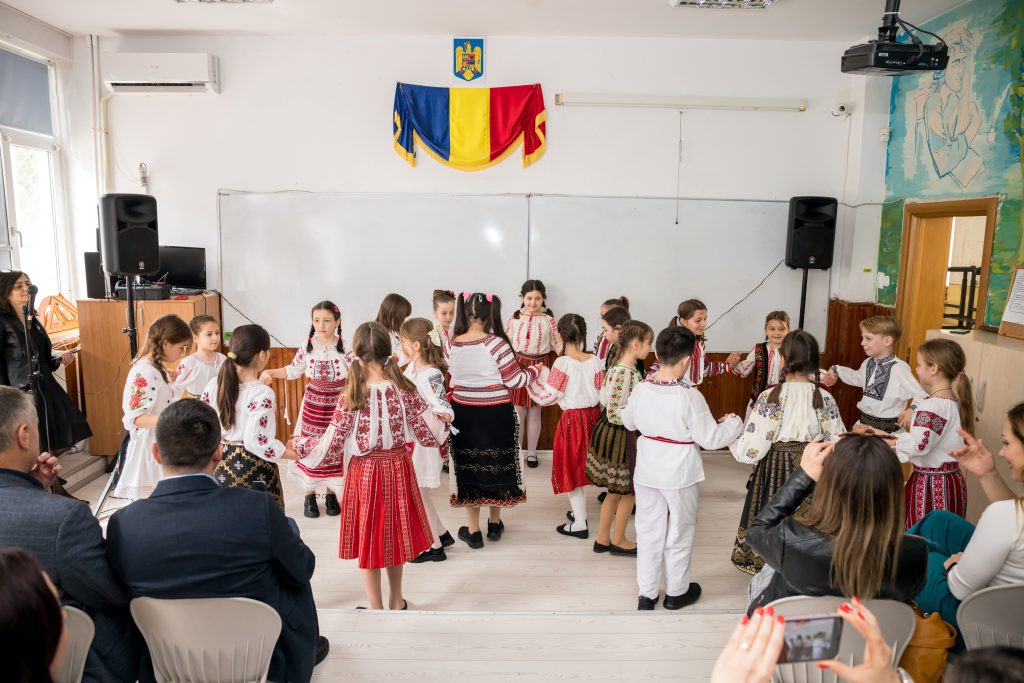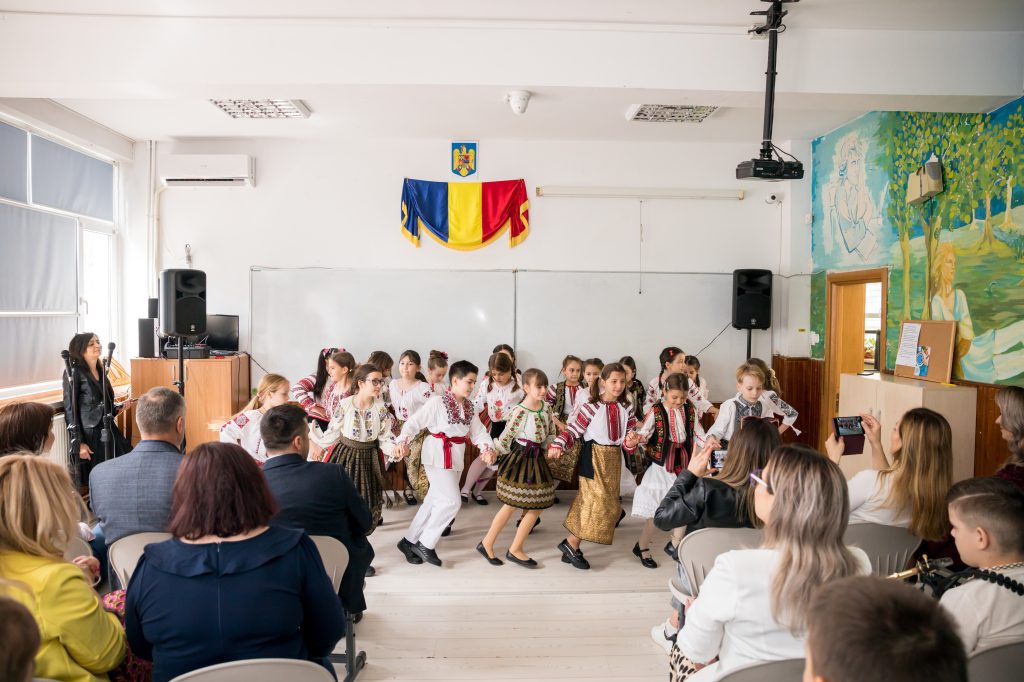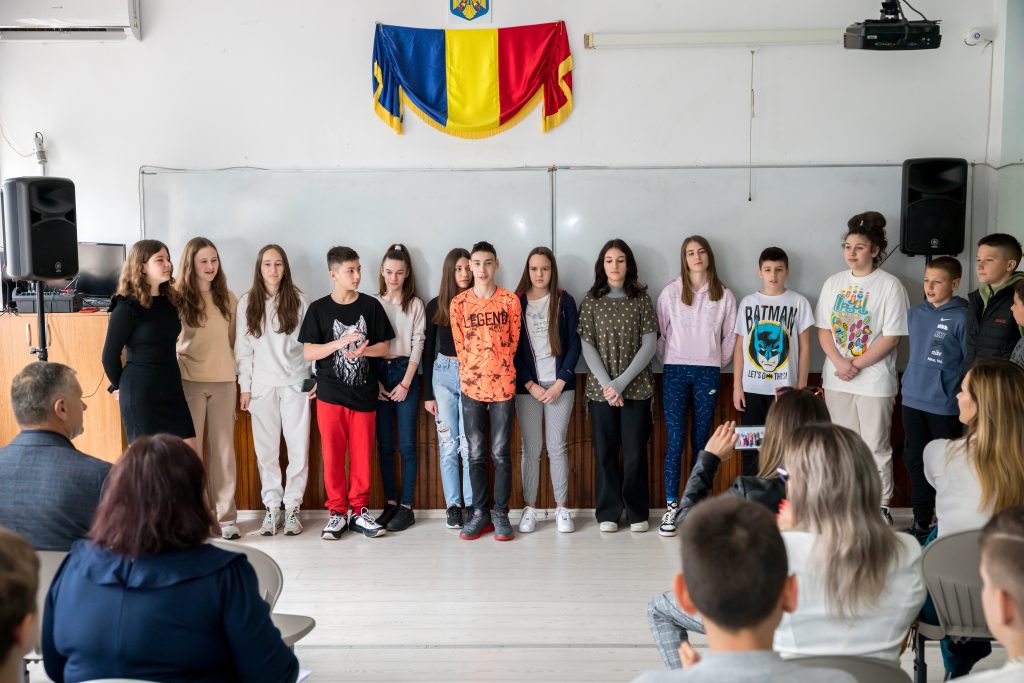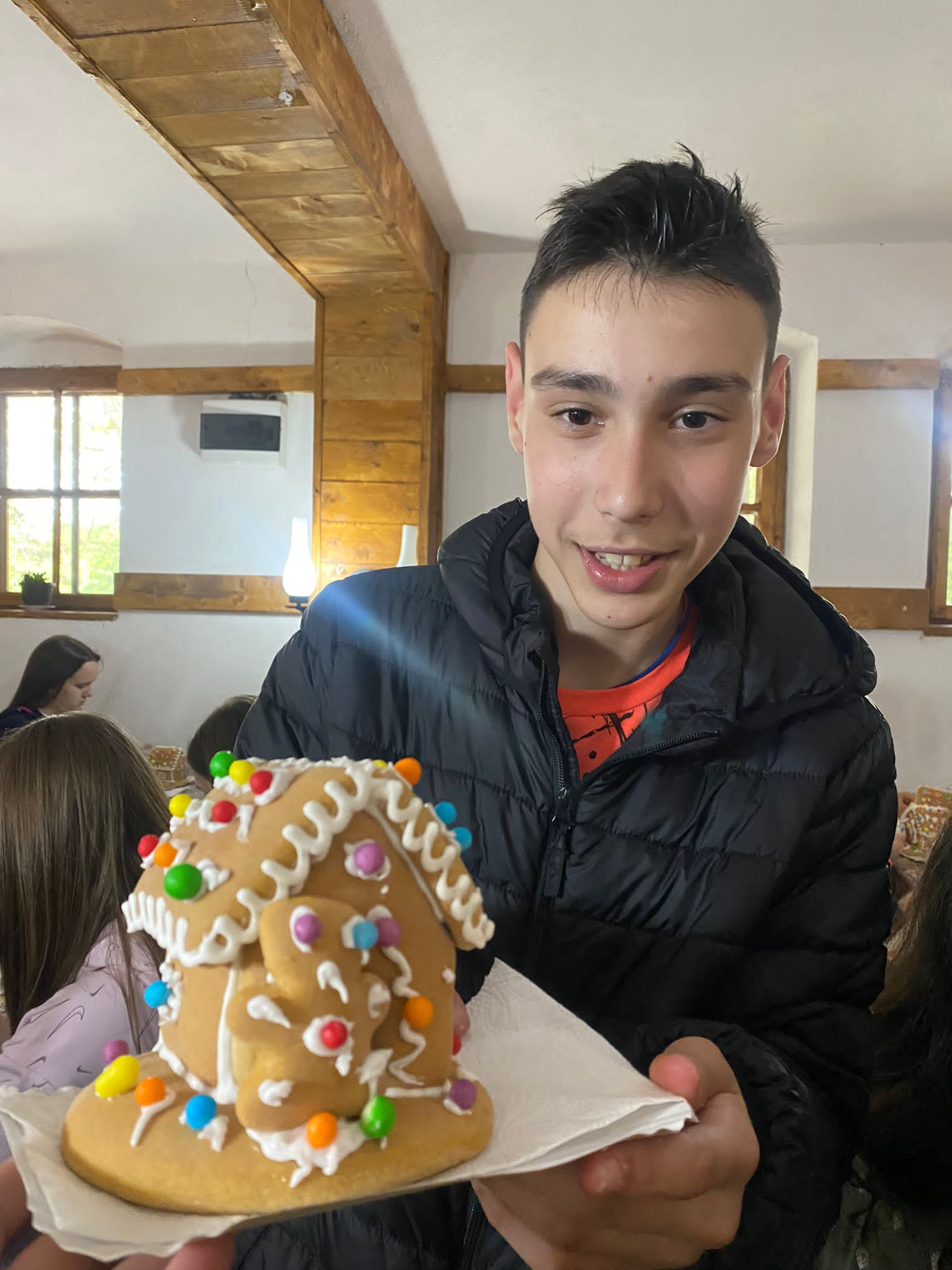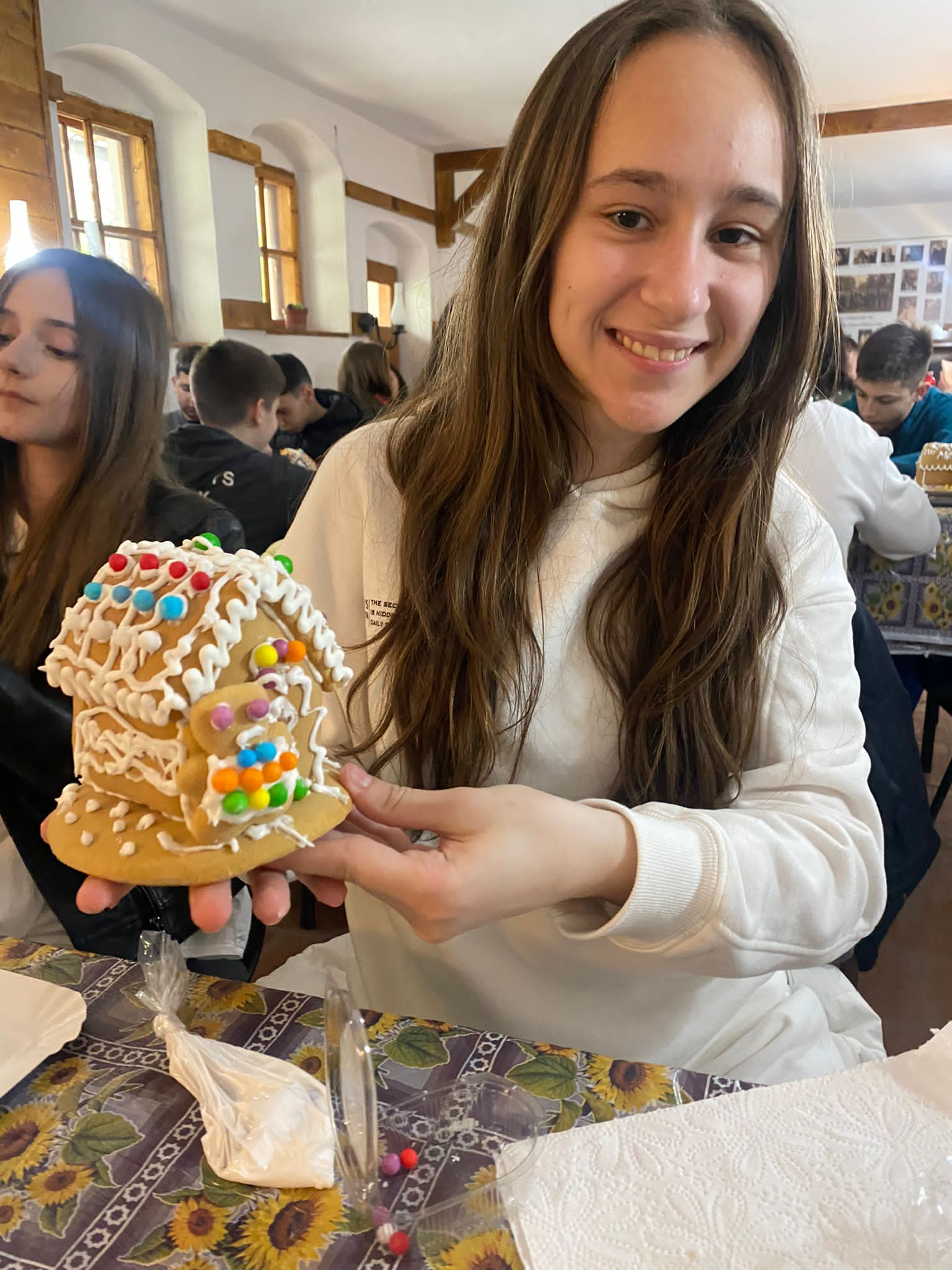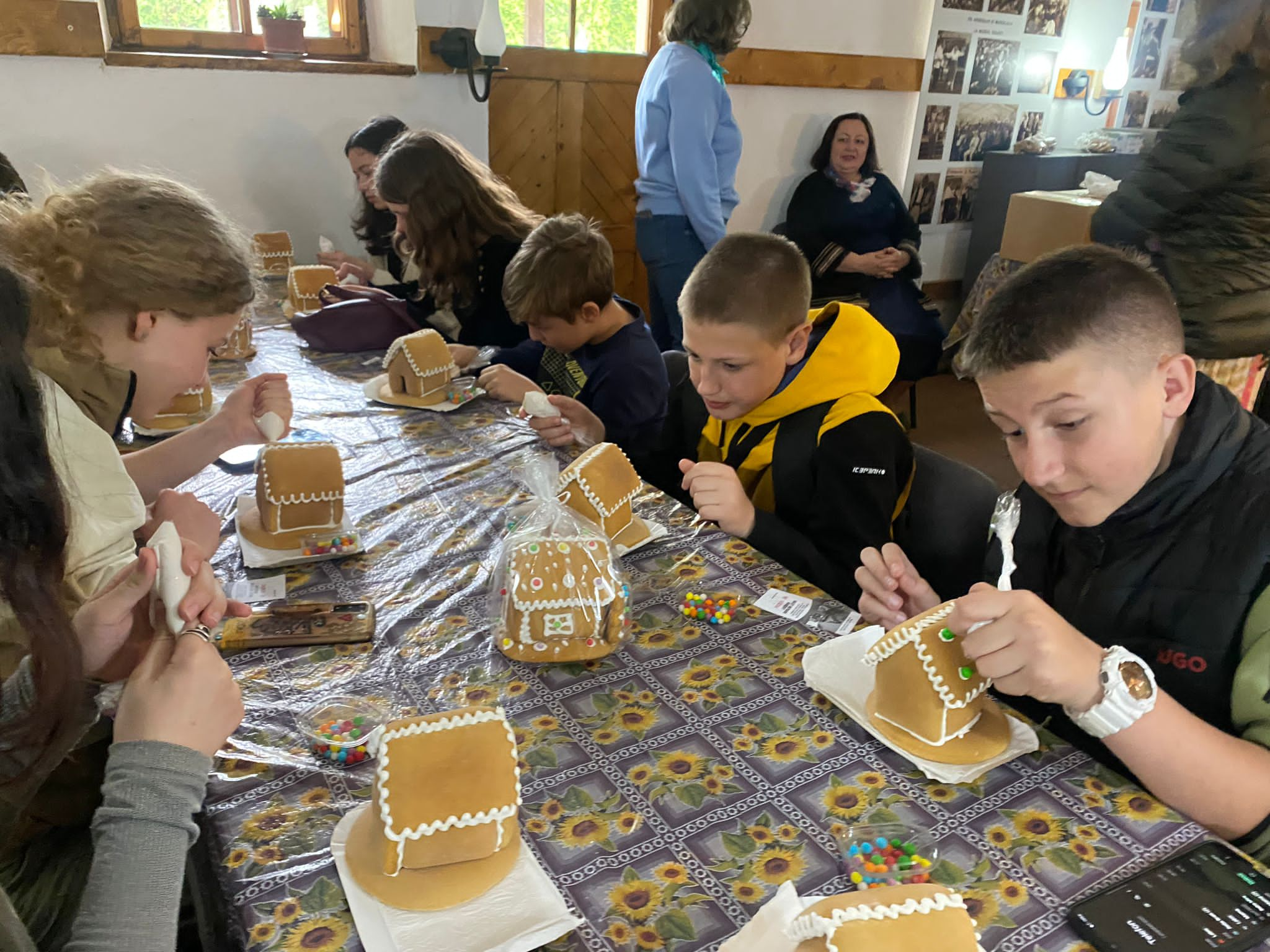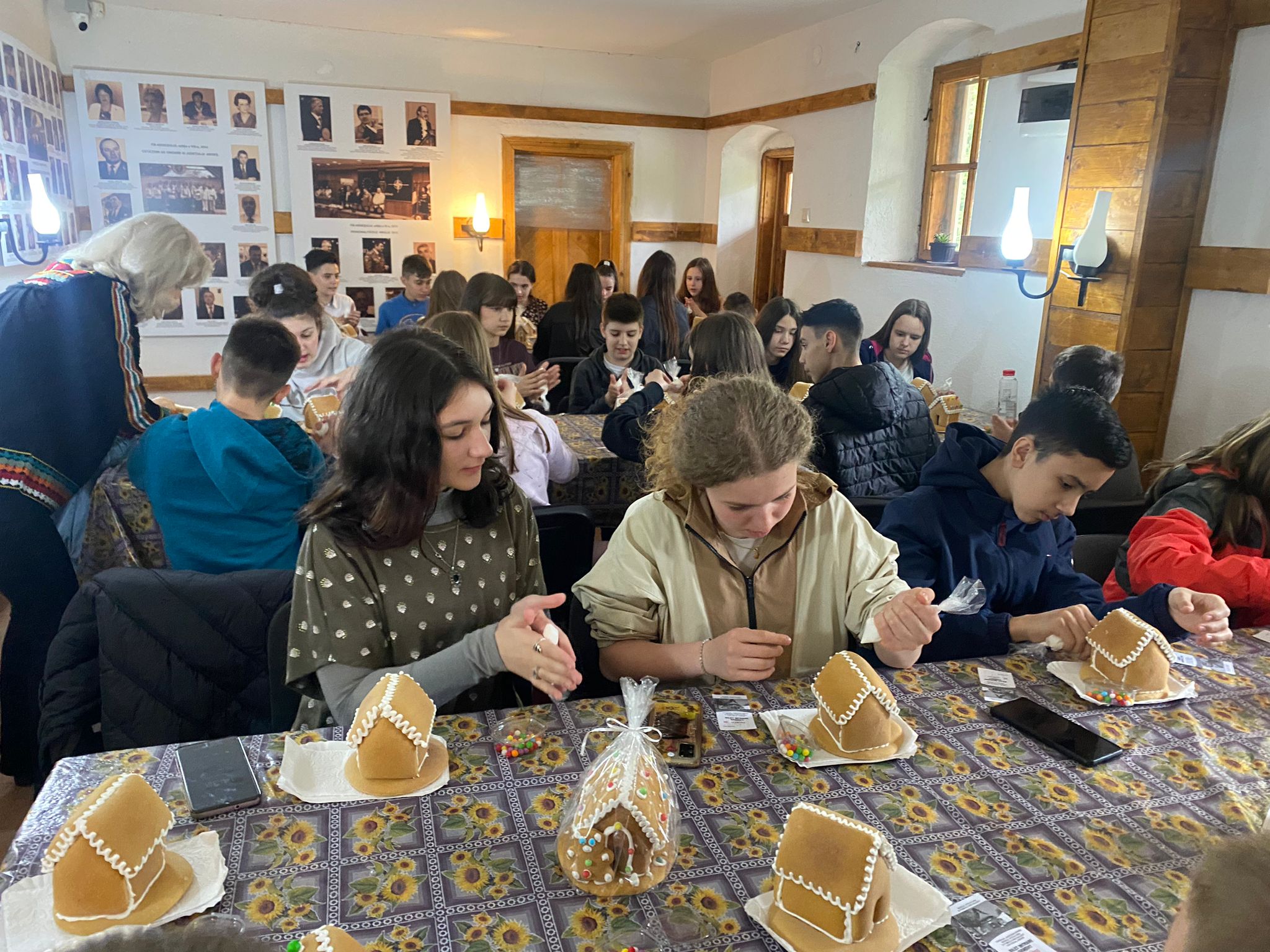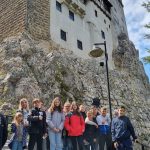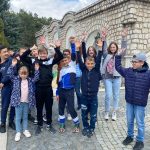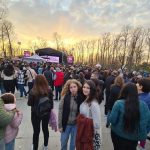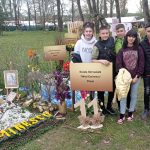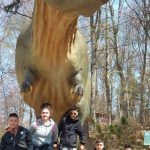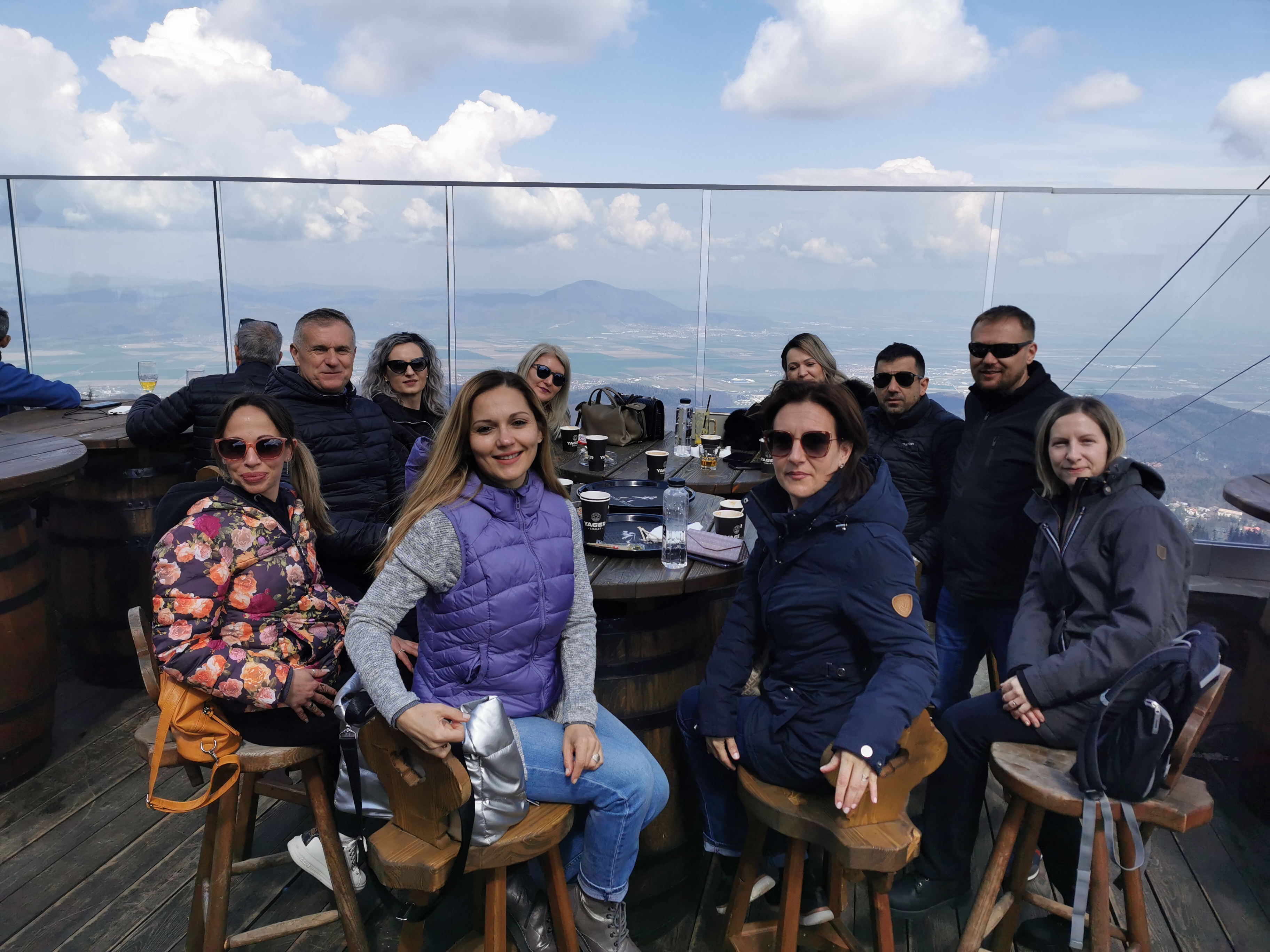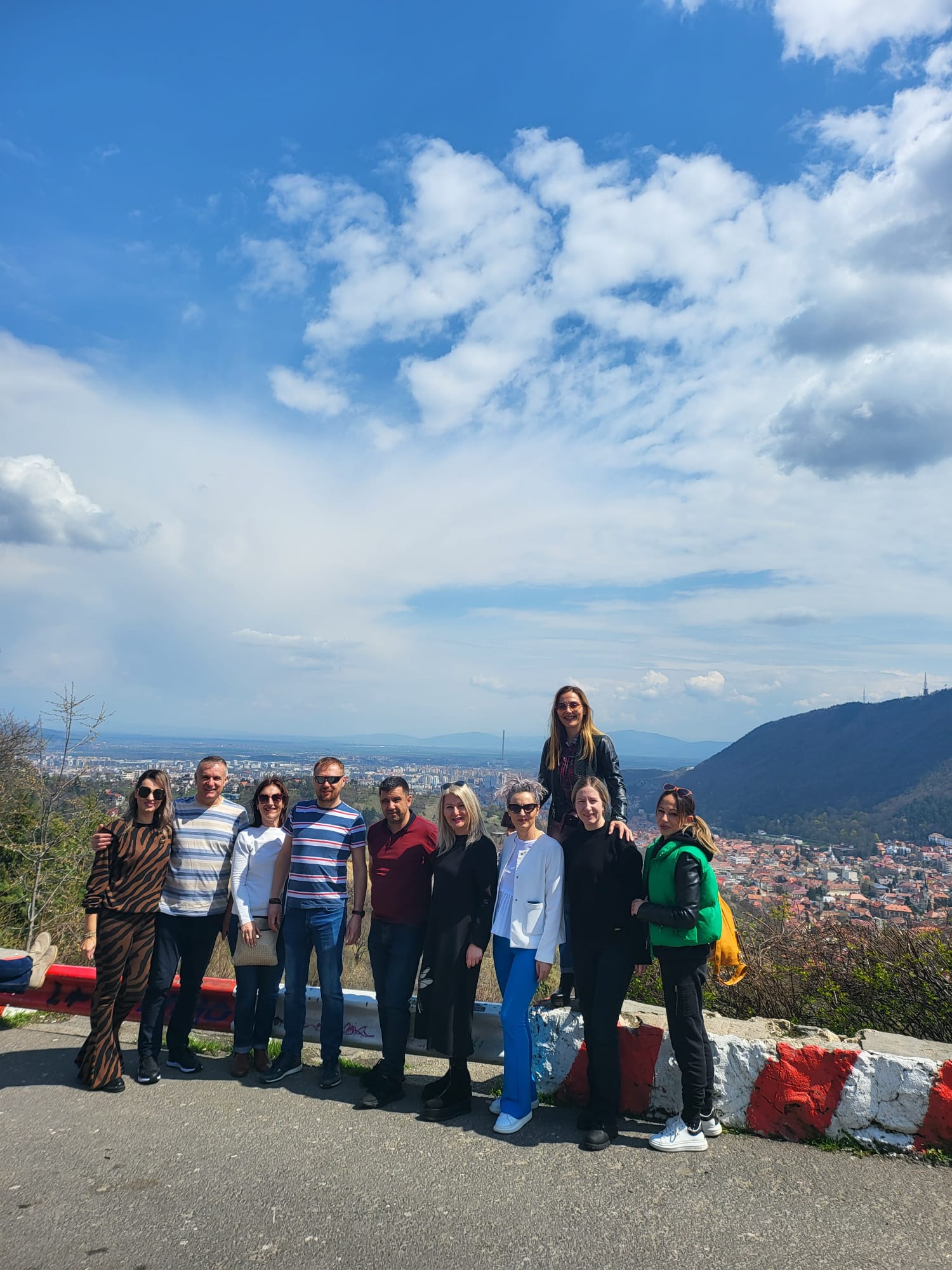O prietenie precum un vin nobil
„Vin sârbii”
Deasupra școlii, soarele se juca de-a „v-ați ascunselea” printre nori albi pufoși ca de vată de zahăr, oglindind din când în când într-o băltoacă din fața porții (semn că sezonul ploios de pe țărmurile oceanului Indian își dăduse întâlnire cu Simfonia lalelelor la Pitești în aprilie) raze portocalii care se împleteau cu emoțiile din privirile copiilor aruncate spre „poarta mare”, pe unde urma să intre autocarul plecat de dimineață din Kragujevac.
„Vin sârbii” era pe buzele tuturor. 15 elevi și 5 profesori de la școala Milutin I Draginja Todorovic din Kragujevac, Serbia, urmau să petreacă 5 zile la noi, într-o nouă etapă a unei prietenii vechi de aproape două decenii.
Cu oarece întârziere (formalități vamale prelungite și drumuri mereu în lucru, aveam să aflăm din mesajele care ne țineau la curent cu ora estimată a sosirii), poarta rulantă dă semnalul prin glasul metalic al roților că prietenii noștri sunt aproape. În scurt timp, directorii celor două școli, Marian Haiducu („al nostru”) și Dragan Pavlovic („al lor”) se îmbrățișează din nou după o pauză de 3 ani cauzată de pandemie.
Ei se cunosc de atâta timp și tot li se citesc pe față emoțiile, ce să mai vorbim de elevii și părinții pe care îi așteaptă o experiență nouă, de neuitat: 5 zile în care puștii din Serbia vor descoperi locuri, tradiții, cultură, preparate culinare, pasiuni și stil de viață românești în sânul familiilor a 15 elevi de vârsta lor din școala noastră.
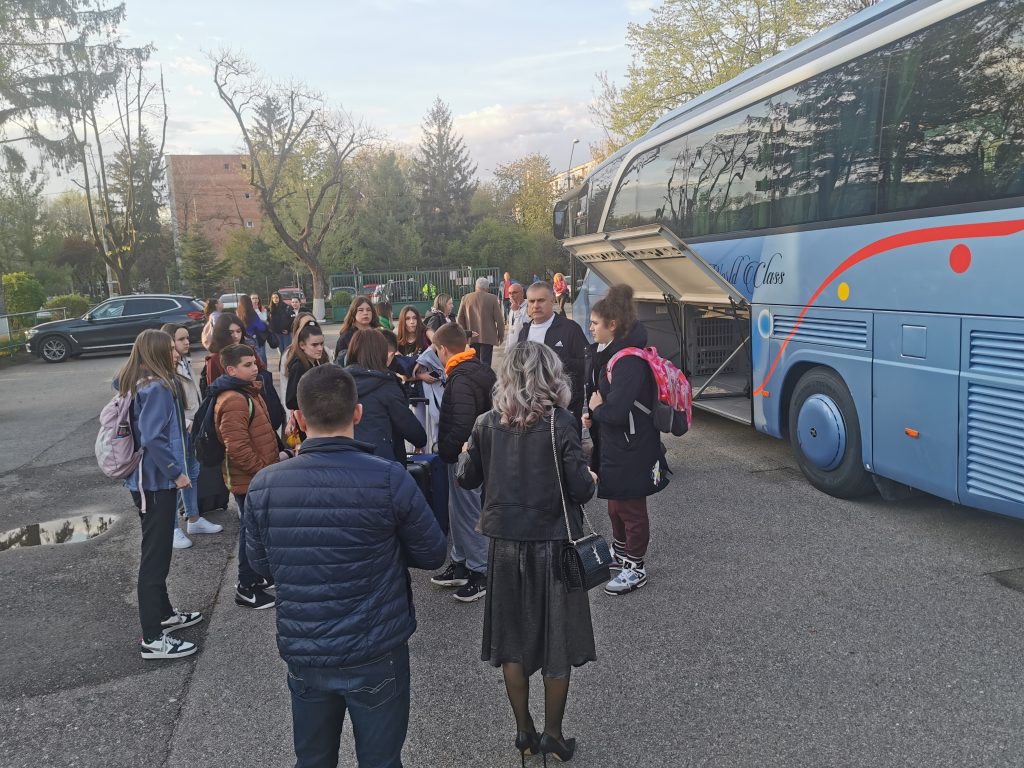
Nu e timp de zăbovit prea mult la școală, copiii sunt obosiți și înfometați de pe drum și îi așteaptă o seară în care apusul soarelui (care, descotorosit de tot de nori, începuse să picteze pe geamurile blocurilor de lângă școală nuanțe obraznice de caramel) va marca începutul unei prietenii ce va dăinui peste timp, asemeni unui vin căruia cel mai priceput pivnicer îi știe secretele păstrării.
„Măi române, românaș”

A doua zi de dimineață, delegațiile celor două școli (cum le-ar caracteriza în limbaj de lemn un rând scris pe prompterul emisiunilor de știri) se întâlnesc în formulă completă în amfiteatrul „Mihai Eminescu”.
Până să înceapă „festivitățile”, copiii discută între ei primele impresii. Din surâsurile de pe fețele lor îți poți da seama că tuturor li s-au depășit așteptările (și ăsta e doar începutul).
În buna tradiție, se face schimb de cadouri între școli, se țin discursuri scurte și presărate cu umor (un lucru ce leagă intrinsec felul de a fi al celor două popoare), după care urmează punctul culminant: momentul artistic pregătit de corul școlii („fetele lui Darius”) și formația de dansuri populare a prichindeilor din clasele primare.
Într-o cheie solemnă, corul interpretează cântecul „Tamo daleko”, un simbol al culturii și identității sârbești, dar și cântece populare românești, în acompaniamentul lui Mihai, saxofonistul nostru mereu jovial, cu plămâni de maratonist și degete care cuprind instrumentul asemenea unor tentacule de caracatiță.
Îmbrăcați în cele mai frumoase costume populare și cu glasuri confundându-se ușor cu triluri de primăvară la marginea unei păduri, micuții dansatori încing câteva hore într-o coregrafie înduioșătoare.
Elevii sârbi nu se lasă mai prejos și interpretează ad-hoc (fiindcă momentul nu era trecut pe foaia Anelor noastre – prezentatoarele spectacolului), spre deliciul tuturor celor prezenți, o piesă cu origini pe dealurile Jidveiului: „Măi, române, românaș”.
Căsuțele dulci de sub podgorii
După o vizită prin clase, grupul deja închegat de elevi români și sârbi se urcă în autocar, cu destinația Golești.
La poalele dealurilor împânzite de viță de vie ale Ștefăneștilor, în incinta muzeului Golești, printre casele cu bârne de stejar ale căror fibre păstrează parfumul secular al satului românesc autentic, 30 de copii își ascund emoțiile în căsuțe de turtă dulce pe care le asamblează singuri sub îndrumarea unui meșter popular. Degetele lor, obișnuite să tasteze mesaje într-un ritm ce ar stârni invidia oricărui dactilograf din secolul trecut, se încumetă să deprindă destul de repede modelarea pereților de turtă dulce pe „umerii” cărora acoperișurile glazurate par niște creste înzăpezite. În urmă cu peste un veac, străbunicii lor ridicau sate întregi din ingrediente mai durabile și mai puțin comestibile: lut, paie și bălegar.
Muzeul Viticulturii și Pomiculturii este un prim loc în care elevii intrați pe Porțile de Fier cu sete de aventură și cunoaștere intră în contact cu istoria și civilizația țării noastre.
Andjela și Ana, Mihajlo și Darius, Uros și Andrei, Isidora și Ana, Janko și Mihai, Masa și Maia, Petar și Alex, Sofija și Ștefania, Viktoria și Maia, Anja și Antonia, Maja și Ana-Maria, Nikolina și Jasmina, Andelina și Ingrid, Sava și Ștefan, Petar și Lucian sunt de azi înainte micii ambasadori ce pictează în joacă poduri de zâmbete (ale unei prietenii fără frontiere) pe un colț de cer de unde se vede deja răsărind prima rază de speranță de care viitorul unei lumi măcinate încă de război își va agăța destinul.
Mii de poze stau mărturie că cele 5 zile petrecute împreună au fost amețitor de intense.
Castelul Bran și al lui conte cunoscut în lumea întreagă, Simfonia lalelelor, Barajul Vidraru, sarmale, Palatul Parlamentului, ie, Brașov, mici, mănăstirea Curtea de Argeș, horă…
Sunt doar câteva dintre cuvintele învățate în limba română cu care elevii sârbi, odată întorși acasă, vor povesti pe nerăsuflate colegilor și familiilor lor experiența acestor zile.
Căruțe și BMW-uri
Și cei 5 profesori de la școala Milutin I Draginja Todorovic au avut parte de un program încărcat, condimentat din plin cu istorie și tradiții românești.
Ai noștri le-au pregătit o excursie de 3 zile în care au făcut cunoștință cu o bucățică din frumusețea Transilvaniei.
Orașul de la poalele Tâmpei, cu centrul istoric și străduțele cochete i-a primit în straie de sărbătoare, manifestarea ce datează din 1728, Junii Brașovului, fiind în plină desfășurare.
Cafeaua pe terasa cocoțată pe Postăvaru la 1700 de m altitudine, înconjurată încă de zăpadă, a avut o aromă aparte.
Castelul lui Dracula a fost de asemenea un loc de neratat.
Locul de suflet al proaspătului încoronat rege al Marii Britanii, satul Viscri, i-a fascinat într-un mod aparte. La capătul parcării încropite pe un drum de pietriș începeau ulițele străjuite de case săsești colorate, pe care se plimbau agale trăsuri trase de cai. Din turnul bisericii fortificate, deasupra copacilor înfloriți, departe de forfota orașelor, ne-am simțit ca niște călători în timp, pe vremea când satul românesc, așa cum emoționant remarca Lucian Blaga, era martorul nașterii veșniciei.
Apropo de asta…
Timp, încotro mergi?
Nimeni nu poate spune când au trecut cele 5 zile. E deja luni dimineață și în curtea școlii autocarul își face încălzirea pentru drumul lung de întoarcere.
În jurul lui, sub teii pe care poetul nostru nepereche îi evocă atât de des în versurile sale, se strâng inimi în brațe, se preling lacrimi pe obraji, se șoptesc cuvinte în română, sârbă și engleză, se împachetează amintiri…

Sunt lucruri cu care timpul se comportă așa cum o face cu un vin nobil, dându-le o culoare și o aromă aparte, făcându-le mai frumoase odată cu trecerea anilor. La umbra teilor parfumați, din vârful soclului său de marmură, bustul lui Eminescu (și nu numai el) poate confirma asta zi de zi.
Este și cazul prieteniei dintre două școli de pe maluri diferite ale Dunării, pentru care soarele închină de două ori pe an o cupă din cel mai efervescent și mai dulce vin spumant.

Ne revedem în octombrie, prieteni!
Noroc! Živeli!
English version
English version
A friendship in the spirit of a noble wine
”The Serbs are coming”
Up above our school, the sun was playing hide-and-seek among cotton candy like fluffy white clouds, occasionally reflecting in a puddle in front of the gate (a sign that the rainy season on the shores of the Indian Ocean had met the Symphony of The Tulips in Pitesti in April) orange rays weaving with the excitement in the children’s eyes cast towards the “big gate”, where the bus that had left Kragujevac in the morning was about to enter.
“The Serbs are coming” vibrated on everyone’s lips. 15 students and 5 teachers from Milutin I Draginja Todorovic School in Kragujevac, Serbia, were going to spend 5 days with us, as part in a new stage of an almost two decade-old friendship.
With some delay (prolonged customs formalities and roads always under construction, we would learn from the messages that kept us informed of the estimated arrival time), the rolling gate`s metallic sound of wheels gives the signal that our friends are close. In a short time, the principals of the two schools, Marian Haiducu (“ours”) and Dragan Pavlovic (“theirs”) hug each other again after a 3-year break caused by the pandemic.
They have known each other for so long and you can still read their excitement on their faces, needless to mention about the students and parents who are about to live an unforgettable experience: 5 days in which the children of Serbia will discover places, traditions, culture, Romanian cuisine, passions and lifestyles in the heart of the families of 15 similarly aged students from our school.
There is no time for too much loitering at school, the children are tired and hungry from the trip and this evening, the setting sun (which, freed from the clouds, had begun to paint naughty shades of caramel on the windows of the blocks nearby) will mark the beginning of a friendship that will endure time, like the wine whose secrets of preserving are only revealed to the most skillful cellarer.
”Măi române, românaș”
The next morning, the delegations of the two schools (as a line written on the prompter of the news broadcasts would mention them in raw language) meet in full formula in “Mihai Eminescu” amphitheatre.
Before the “festivities” begin, the children share their first impressions. You can tell by the smiles on their faces that everyone’s expectations have been exceeded (and that’s just the beginning).
In the good old manner, gifts are exchanged, short speeches spiced up with humor are given (humour intrinsically links the way of being of the two peoples), and the climax coming up next: the artistic moment set up by the school choir (“the girls of Darius”) and the folk dance group of primary school children.
In a solemn note, the choir performs the song “Tamo daleko”, a symbol of the Serbian culture and identity, as well as Romanian folk songs, accompanied by Mihai, our always jovial saxophonist, with lungs of a marathon runner and fingers that grasp the instrument like tentacles of an octopus.
Wearing the most beautiful folk costumes and with voices slightly blending with spring trills at the edge of a forest, the little dancers warm up a few `horas` in an impressive choreography.
The Serbian students also exceed our expectations by performing ad hoc (because the moment was not written down on the pages of `our Anas` – the presenters of the show), to the delight of all those present, a musical piece with origins in the hills of Jidvei: “Măi, române, romănaș”.
The sweet little houses under the vineyards
After a school tour, the group of Romanian and Serbian students board the bus, bound for Golești.
At the foot of the vineyard-studded hills of Ștefănești, within the Golești museum, among the houses with oak beams whose fibers preserve the centuries-old scent of the authentic Romanian village, 30 children hide their emotions in gingerbread houses that they assemble themselves under the guidance of a folk craftsman. Their fingers, accustomed to typing messages at a pace that would make any typist of the last century jealous, dare to learn rather quickly to model gingerbread walls whose glazed roofs look like snowy ridges. Over a century ago, their great-grandfathers used to raise whole villages from more durable and less edible ingredients: clay, straw and dung.
The Viticulture and Horticulture Museum is a first place where students entering the Iron Gates with a thirst for adventure and knowledge come into contact with the history and civilization of our country.
Andjela and Ana, Mihajlo and Darius, Uros and Andrei, Isidora and Ana, Janko and Mihai, Masa and Maia, Petar and Alex, Sofija and Stefania, Viktoria and Maia, Anja and Antonia, Maja and Ana-Maria, Nikolina and Jasmina, Andelina and Ingrid, Sava and Ștefan, Petar and Lucian are, from now on, the little ambassadors who playfully paint bridges of smiles (of a friendship without borders) on a canvas corner in the sky from where everyone can see the rising of the first ray of hope on which the future of a world still torn by war will hang its fate.
Thousands of pictures stand proof that the 5 days spent together were dizzyingly intense.
Bran Castle and its world-famous count, The Symphony of The Tulips, Vidraru Dam, sarmale, The Palace of Parliament, ie, Brașov, mici, Curtea de Argeș Monastery, hora…
These are just some of the Romanian words that the Serbian students, once back home, will breathlessly tell their colleagues and families about the experience of these days.
Carriages and BMWs
Likewise, the 5 teachers from Milutin I Draginja Todorovic School have a busy schedule, full of Romanian history and traditions.
We have arranged a three-day trip to impress them with the beauties of Transylvania.
The city at the foot of Tâmpa, with its historic center and charming streets, welcomed them in a festive atmosphere, the event dating back to 1728, under the name of Junii Brașovului, being in full swing. The coffee on the terrace perched on Postăvaru at 1700 m altitude, still surrounded by snow, had a special aroma.
Dracula’s castle was also a must see.
The soul place of King Charles of Great Britain, the village of Viscri, fascinated them in a special way. At the end of the parking lot, on a gravel road, you could see the streets lined up with colorful Saxon houses, where horse-drawn carriages were moving slowly. From the tower of the fortified church, above the blossom trees, far from the hustle and bustle of the cities, we felt like travellers in time, back to when the Romanian village, as Lucian Blaga so movingly remarked, witnessed the birth of eternity.
By the way…
Time, where are you heading to?
No one can tell when the 5 days have passed. It’s already Monday morning and in the school yard the bus is warming up for the long journey back.
Around it, under the linden trees which our peerless poet evokes so often in his lyrics, young souls hug, tears run down cheeks, words are whispered in Romanian, Serbian and English, memories are packed…
Time treats such things as it does with a noble wine, giving them a special color and flavour, making them more beautiful once with the years passing. In the shade of the fragrant linden trees, from the top of its marble plinth, Eminescu (and not only him) can confirm this every day.
It is also the case of the friendship between two schools on different banks of the Danube, for which, twice a year, the sun raises a glass of the sweetest and most effervescent sparkling wine.
See you in October, dear friends!
Noroc! Živeli!

